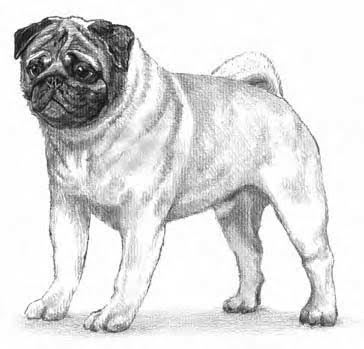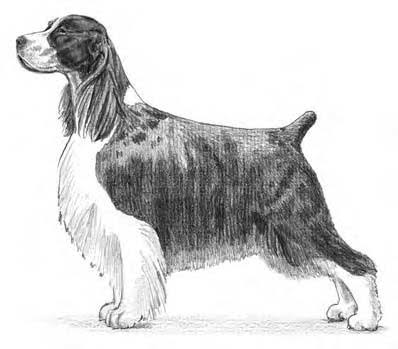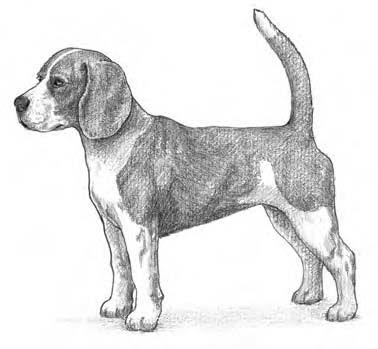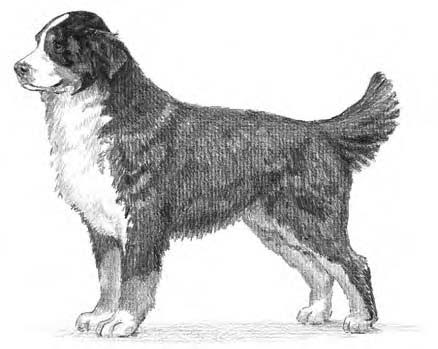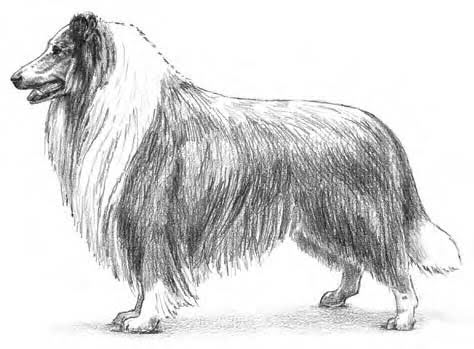In This Chapter
- Pinpointing your ideal breed or mixed breed
- Understanding what makes a breed (or mix of breeds) unique
- Getting the scoop on the terms “breed groups,” “designer breeds,” and “hybrid vigor”
Sure, almost all puppies love dog biscuits and a scratch behind the ears, but the similarities pretty much end there. All dogs face the world in different ways. Some thrive on human interaction; others prefer an independent lifestyle. Some love the general mayhem created by small children, while others find it less than thrilling. Some see houseguests as long-lost friends, and others see them as potential enemies. Some dogs cherish quiet, solitary times; others eat your house if you come home too late. What sounds good to you?
Assembling Your Needs and Wants: A Breed Questionnaire
Remember
Getting a puppy is no short-term thrill. In fact, the thrill is relatively shortlived. As your puppy grows, you’ll be responsible for all the care, love, and training of a developing dog who will share the next decade and a half with you and (hopefully) enrich your life.
The questions
Interpreting your answers
Warning!
You’ll find high costs associated with healthcare and maintenance of many breeds. For example, long-, thick-, or curly-coated dogs need regular professional grooming. Professional groomers charge between $35 and $100 and are needed every three to six weeks. Also, short-snouted dogs are prone to respiratory problems that may warrant medical attention. Developmental complications, such as joint dysplasia, chronic skin and ear conditions, heart murmurs, and eyelid malformations, are also found in some breeds. All this healthcare and maintenance costs money — are you prepared to pay?
Questions 6–20
– Questions 6 and 7: These questions target the essence of your dog’s personality. Some breeds are spirited and fiercely independent. Others watch you closely and can’t seem to make a decision without weighing your opinion. And then you’ll also find the in-between breeds who would choose to follow but won’t destroy the furnishings if you go out to do errands. What appeals to you: A dog who needs you desperately (for example, a Shetland Sheepdog or a Cavalier King Charles Spaniel) or a dog who’s content with time apart (such as a Cairn Terrier or an Airedale)?
– Question 8: The amount of exercise you’re able to give your new pooch should be a key factor in choosing a dog breed. If you’re honest here, this question will help you discover what breed’s energy level you can match. Even though an active breed may sound dreamy, if you can’t provide constant attention and exercise for the next decade, cross it off your list.
Remember
A Golden Retriever is an acclaimed family dog, but he’ll need a lot of attention, reassurance, and exercise — pent-up energy or isolation can cause the retriever to destroy the house or to become clingy and impulsive. These behaviors will no doubt be frustrating for your family.
– Questions 9–11: How involved in your life would you like your dog to be? If socializing is high on your priority list, choose a breed that was bred to take direction and follow humans around (Retrievers and herding breeds, for example). Though all dogs will enjoy being near you 24/7, breeds that were designed to work independently of man (such as Siberian Huskies, Terriers, and guarding dogs) are more mentally equipped to handle periods of isolation.
– Questions 12–14: These questions pinpoint why you’re getting a dog. Does the thought of a dog’s protection appeal to you? If so, you may want a Rottweiler or a Mastiff. Do you like being alerted to outside noises, or do you want a companion who just rolls with the comings and goings of the outside world? If you’re interested in a playmate for your children, a retrieving breed or spaniel may be an ideal choice.
– Questions 15–16: These questions dive deep into the time-commitment issue. Training a dog to bark at the “right” things is a key consideration for all breeds throughout their first year. The amount of time you need to commit is determined by both the breed and the personality of each individual puppy. Strong, independent, and dominant puppies, such as boxers or bull terriers, need more structure and stern reinforcement than passive, dependent, and sweet-natured puppies.
– Question 17: Grooming is another time consideration. All dogs need a good brushing from time to time, but long-, thick-, curly-, or featherycoated breeds (such as Golden Retrievers, Shepherds, or Shih Tzus) need a commitment (daily brushings) and periodic professional groomings, which may become costly!
– Question 18: Sharing time with your puppy is a healthy way to establish trust and friendship. Consider your favorite pastime and find a breed that is in the same groove as you. For example, if you’ve got a fetish for Frisbees, you’ll have to decide whether you want a dog who fetches them relentlessly or one who shows no interest (so that you can actually play a civilized game with friends or family).
Warning!
– Question 19: Introducing a new puppy to other pets in your household can be tricky, so take this question seriously. If you breed prize-winning rabbits, avoid breeds genetically programmed to kill them (such as Terriers). If you have another dog, choose a breed that will mesh with his traits and personality.
– Question 20: If you have other considerations write them down and think through them in terms of the future. For example, say you were planning to have a child in a couple of years. Does that mean you want a protective dog to stand guard, or a cheerful spirit to welcome your child at the door?
Questions 21–30
Do You Want a Pure or Mixed Breed?
– Pure breeds: There are over 420 identified purebred dog breeds around the world. Each has been fine-tuned by humans to perform a specific function in society. Although most breeds don’t “work” anymore, fanciers continually devote themselves to breeding and selling puppies that reflect their traditions. Choosing a specific breed will enable you to predict the size, weight, and interest of your puppy.
– Mixed breeds: Dogs are blind to these specifics. An unorchestrated meeting can result in a mixed variety of puppies. Since these puppies are often produced “by accident,” many of them end up being given to the shelter or given away. No love is lost, however — a mixed-breed dog is often healthier due to the increased gene pool, and these dogs are just as capable of loving their owners.
Predictability reigns: Discovering purebred dogs
Mixing the breeds: Discovering hybrid vigor
Remember
A mixed-breed dog is every bit as delightful as a purebred dog, and as some argue, healthier mentally and physically by virtue of hybrid vigor. Hybrid vigor is a term that refers to a mixed-breed dog’s gene pool: By matching two completely different breeds, you get an ever expansive possibility of traits. Hybrid vigor advocates attest to healthier dogs because of the greater number of available genetic bundles. When mixed breeds are mated, it’s assumed that the healthy traits will be dominant, and because there are more options, the genetic make up of the dog is better. Do I believe in this theory? Absolutely!
Chiweenie Chihuahua/Dachshund
Doodleman Pinscher Doberman Pinscher/Poodle
Jack-A-Bee Jack Russell Terrier/Beagle mix
Labernese Labrador Retriever/Bernese Mountain Dog
Pomimo American Eskimo/Pomeranian
Puggle Pug/Beagle
Shorgi Corgi/Shih Tzu
Torkie Toy Fox Terrier/Yorkshire Terrier
Zuchon Shih Tzu/Bichon Frisé
Remember
One catch to choosing a designer breed is that you can’t exactly be sure of what you’re going to get. A purebred dog can be predicted down to the size, weight, and interests. A mixed-breed dog, designer or not, will have a random mix of either traits in no particular order. If you’re thinking of buying one of these fun and fancifully named breeds, make sure you like both mixes — you could end up with the look of one and the personality of the other.
Warning!
Beware of buying a “designer mix” from a pet store. Commonly bred in puppy mills in deplorable conditions, they’re separated from their moms far too young and then sold at exorbitant prices. It’s a travesty — buyer beware — the puppy suffers!
Picking Your Pup among Seven Standard Breed Groups
Just for fun
The first Westminster Dog Show was held in 1877, making this annual event the second oldest sporting event in the United States. Only the Kentucky Derby, which began in 1875, has been around longer.
Team players: The Sporting Group
– Pointers:
- German Shorthaired Pointer
- German Wirehaired Pointer
- PointerVizsla
- Weimaraner
- Wirehaired Pointing Griffon
– Retrievers:
- Chesapeake Bay Retriever
- Curly-Coated Retriever
- Flat-Coated Retriever
- Golden Retriever
- Labrador Retriever
– Spaniels:
- American Cocker Spaniel
- American Water Spaniel
- Clumber Spaniel
- English Cocker Spaniel
- English Springer Spaniel
- Field Spaniel
- Irish Water Spaniel
- Sussex Spaniel
- Welsh Springer Spaniel
– Setters:
- Brittany
- English Setter
- Gordon Setter
- Irish Setter
Warning!
Even though these loyal and cheerful dogs have well-earned reputations as patient family pets, they need both mental and physical stimulation. They can’t cope with long hours of isolation, because it, along with lack of exercise, will only fuel anxiety. An unhappy Sporting Dog is destructive, hyper, and impulsive. This isn’t a good mix — especially for your couch and end table.
Which way did he go? The Hound Group
Remember
Originally teamed in pairs or packs, each was prized for its instinct to follow game without depending on human direction. As a result, a hound’s affable manner and pack mentality results in a dog who enjoys family life and yet is independent enough to entertain himself.
– Sight hounds:
- Afghan Hound
- Irish Wolfhound
- Basenji
- Pharaoh Hound
- Borzoi
- Saluki
- Greyhound
- Scottish Deerhound
- Ibizan Hound
- Whippet
Warning!
Sight hounds must be kept on a lead when outdoors because you can’t outrun them, and their instinct to chase hasn’t been bred out of them. In addition, you need to socialize sight hounds to common household pets (like cats, birds, and rabbits) at an early age; otherwise, they may confuse them for lunch as they race across your floor.
– Scent hounds:
- Basset Hound
- American Foxhound
- Beagle
- English Foxhound
- Black and Tan Coonhound
- Harrier
- Bloodhound
- Otterhound
- Dachshund
- Petit Basset Griffon Vendén
– Large game hounds:
- Norwegian Elkhound
- Rhodesian Ridgeback
Leave it to me: The Working Group
Warning!
Choose a dog from this group only if you can use and appreciate his skills. For example, Great Pyrenees and Kuvasz were originally bred to guard flocks. Because their work ethic is still intact, they make ideal watchdogs when trained. If left to their own devices, however, they often take their instincts to the extreme, assuming you and those in your circle are sheep that need to be protected. Dinner guests won’t be welcome, and the postman best beware!
– Sled dogs:
- Alaskan Malamute
- Samoyed
- Siberian Husky
Warning!
With their double coat, sledding breeds aren’t much for really hot weather. If you live in a hot climate, consider another breed. These dogs would be miserable.
– Draft dogs:
- Bernese Mountain Dog
- Greater Swiss Mountain Dog
– Guard dogs:
- Akita
- Komondor
- Anatolian Shepherd
- Kuvasz
- Bullmastiff
- Mastiff
- Great Dane
- Rottweiler
- Great Pyrenees
Warning!
Raising children and dogs is challenge enough. Territorial breeds can overstate their job as guardian, protecting your home and children against all intruders — including friends, extended family members, daily workers, and even other children. These dogs quickly suffer career stress in busy houses. If your heart’s set on a territorial breed, structured training is a must.
– Personal protection dogs:
- Boxer
- Doberman Pinscher
- Giant Schnauzer
- Standard Schnauzer
– Rescue/water dogs:
- Newfoundland
- Portuguese Water Dog
- Saint Bernard
Shepherd or sheep? The Herding Group
So how big is large? | |||
Dogs come in all shapes and sizes. Unfortunately, the sizes aren’t as simple as big and little. The following table can help you figure out how big large is and how little small is — just in case you ever need to know. | Category Small Medium Large Giant | Height Up to 10 inches 10–20 inches 20–27 inches 27+ inches | Weight 2–20 pounds 20–50 pounds 50–90 pounds 90+ pounds |
– Sheep herders:
- Australian Shepherd
- Collie
- Bearded Collie
- German Shepherd Dog
- Belgian Malinois
- Old English Sheepdog
- Belgian Sheepdog
- Puli
- Belgian Tervuren
- Shetland Sheepdog
- Border Collie
– Cattle/sheep driving dogs:
- Australian Cattle Dog
- Canaan Dog
- Briard
- Cardigan Welsh Corgi
- Bouvier des Flandres
- Pembroke Welsh Corgi
Warning!
If the herding breeds aren’t given an outlet for their impulses, they can develop obsessive, patterned behaviors like circling a table or chasing fastmoving targets such as automobiles or joggers. For drovers that are understimulated, their pacing creates a well-trodden path in a yard or field. Guarders must be trained, lest they adopt their people or children as sheep to protect. Cattle dogs are serious-minded, strong, and stocky dogs who can develop repetitive behaviors such as nipping your (or your children’s) moving ankles.
Hot diggity! The Terrier Group
– Vermin hunters:
- Airedale Terrier
- Manchester Terrier
- Australian Terrier
- Miniature Schnauzer
- Bedlington Terrier
- Norfolk Terrier
- Border Terrier
- Norwich Terrier
- Cairn Terrier
- Scottish Terrier
- Dandie Dinmont Terrier
- Sealyham Terrier
- Fox Terrier (Smooth and Wirehaired)
- Skye Terrier
- Irish Terrier
- Soft Coated Wheaten Terrier
- Jack Russell Terrier
- Welsh Terrier
- Kerry Blue Terrier
- West Highland White Terrier
- Lakeland Terrier
Remember
Don’t be surprised if your terrier breed lifts his lip as you (or anyone else) reach for his bone or food bowl. It’s a natural reaction called spatial aggression, and it’s similar to what a young child who doesn’t want to share a favorite toy does. Other dogs known for this behavior include some working breeds, hounds, and certain toy breeds. For suggestions in overcoming this dilemma, refer to Chapter Food and Fitnes.
– Fighters:
- American Staffordshire Terrier
- Miniature Bull Terrier
- Bull Terrier
- Staffordshire Bull Terrier
Although the fighting breeds have a combative history, most of the breeding lines have all but extinguished this impulse. Extensive socialization can ensure a friendly attitude toward other dogs and pets.
Warning!
Though rare, some owners still use some of the fighting breeds for sport. These owners usually won’t neuter the dog (as doing so would diminish their fighting tenacity) and often neglect them. Because of this mistreatment, these dogs’ genes can seep into the domesticated gene pool, possibly causing the breed to be more aggressive. When choosing a dog from this group, trace its history or talk openly with the breeder or previous owner about their breeding philosophy and the temperaments of the dog’s parents.
All mixed up: The Non-Sporting Group
– American Eskimo Dog
– French Bulldog
– Bichon Frisé
– Keeshond
– Boston Terrier
– Lhasa Apso
– Bulldog
– Löwchen
– Chinese Shar-Pei
– Poodle (Standard and Miniature)
– Shiba Inu
– Schipperke
– Chow Chow
– Tibetan Spaniel
– Dalmatian-
– Tibetan Terrier
– Finnish Spitz
Snuggle puppy: The Toy Group
– Affenpinscher
– Miniature Pinscher
– Brussels Griffon
– Papillon
– Cavalier King Charles Spaniel
– Pekingese
– Chihuahua
– Pomeranian
– Chinese Crested
– Pug
– English Toy Spaniel
– Shih Tzu
– Havanese
– Silky Terrier
– Italian Greyhound
– Toy Manchester Terrier
– Japanese Chin
– Toy Poodle
– Maltese
– Yorkshire Terrier
Tip
When assessing specific breeds, research their ancestry. Even though their size is clearly different, their genetic impulses may be undeniably similar. Don’t pass on training them simply because of their stuffed-animal-like appearance. Constant affection without direction results in a Napoleon-like complex, which is reflected in behaviors from chronic barking to marking and often aggression. You’d be surprised how much damage a 5-pound dog can inflict!
Warning!
Toy breeds are fragile by design. Even though certain breeds are stockier (the Pug and the Cavalier King Charles Spaniel, for example), they’re all tiny — especially as puppies. Be mindful of this puppy around larger dogs and young children. Toddlers can easily hurt or overwhelm the puppies because they may mistakenly confuse them for stuffed animals.
Sarah Hodgson




